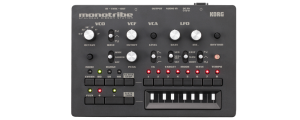I picked up a Korg Monotribe around the holidays. Its cheap price made for a perfect gift card purchase. The Monotribe is an easy-to-use beatbox that is part of Korg’s recent analog renaissance, including everything from the Monotron series to the upcoming rebirth of the ARP Odyssey. Korg deserves praise for bringing analog to the masses.
Korg Monotribe Features
- Analog VCO, VCA, and VCF
- Ribbon Keyboard
- Analog Drum Sounds
- Step Sequencer
- Multi-Function LFO
- Street Price Under $200
- Active Step Function allows Different Time Signatures
- Internal Speaker
- Powered by Battery or AC
- External Input and Sync I/O
The Monotribe comes with a great analog sound and a full range of features for its price. It’s a great tool for getting youngsters interested in synthesis and beatmaking, but still packs a punch for pros as well.
The Analogue Ribbon Station
The Monotribe’s sound is bright even through its internal speaker. It really stood out when routed through my studio mixer and monitors. The filter’s cutoff and peak knobs control a LPF that’s the same as Korg’s classic MS-20 synth. They offer a biting sound that cuts through any dense mix.

The LFO connects to the VCO, the VCF, or a mix of the two. A switch selects between a fast range (1HZ to 5 kHz), a slow range (0.05HZ to 18HZ), or a one-shot mode. Sawtooth, square and triangle waveforms are used for the carrier. Rate and intensity knobs round out the LFO.
The ribbon keyboard, with its own range control switch, works well enough, allowing for both real-time and step sequencer pitch control. The only real mixing capability is the level knob on the VCA and a separate knob for the rhythm section. Noise can be inserted into the VCO which offers sawtooth, triangle, and square waveforms with a wide pitch control.
The included analog drum samples (kick, snare, and hi-hat) are useful, but unfortunately aren’t modifiable with the built-in filter, EG switch, or LFO. Just their level control, ma’am.
Fun with Step Sequencers
The 8-beat step sequencer is easy to dive into. 16 beats are also possible by adding a new set of intermediate steps in the Monotribe’s settings. The Active Step control, similar to Korg’s Volca series allows different time signatures, and each part — synth, kick, snare, and hi-hat — can have its own time-sig.
Simply pressing one of the part buttons provides access to its sequence, with eight step buttons controlling the on-off status for each separate step. Flux mode allows the pitch to be sequenced continuously over time — useful in concert with the ribbon keyboard. A Gate Time button controls the duration of each note as well.
The big weakness of the Monotribe for me is the inability to save more than one pattern into the device’s memory. That makes it impossible to combine patterns into song-like structures or even easily modulate the existing pattern. You can sync multiple Monotribes together and daisy-chain their sequences, which mitigates the issue somewhat — at a cost.
The lack of an internal delay is another hassle, but I have routed the Monotribe to my Monotron Delay for a blast of noisy sonic freak. It also works well with Electro-Harmonix’s line of analog delay pedals.
The modding community has embraced the Monotribe and with a mod it is possible to add MIDI I/O to the device which makes external sequencer control possible among other useful features. Props to Korg for making the Monotribe’s circuit board easy to read. It appears Korg designed the thing specifically for modding, thus the lack of MIDI and a larger internal memory.
Even with its minor caveats, the Korg Monotribe is a blast and a useful device for analog-style beatmaking. You can buy two or three, sync them together, and really have a party!

Pingback: littleBits Synth Kit - Perfect for Teaching Analog Synthesis | TabMuse -- a Home for Digital and Analog Music Inspiration
Pingback: The iVCS3 raises the Bar for iPad Hardware Emulation | TabMuse -- a Home for Digital and Analog Music Inspiration
Pingback: Korg Volca Keys -- the Analog Synth Reviewed | TabMuse -- a Home for Digital and Analog Music Inspiration